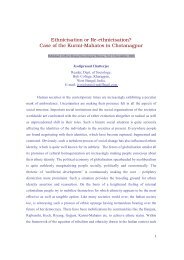Chapter 5 - WebRing
Chapter 5 - WebRing
Chapter 5 - WebRing
You also want an ePaper? Increase the reach of your titles
YUMPU automatically turns print PDFs into web optimized ePapers that Google loves.
CHAPTER 5. MAGNETIC SYSTEMS 275<br />
(a) (b)<br />
Figure 5.18: (a) The ground state of N = 5 Ising spins in an external magnetic field H. For<br />
toroidal boundary conditions, the ground state energy is E0 = −5J −5H. (b) The flip of a single<br />
spin of N = 5 Ising spins. The corresponding energy cost is 4J +2H.<br />
(a) (b)<br />
Figure 5.19: Microstates corresponding to two flipped spins of a system of N = 5 spins in one<br />
dimension. In (a) the flipped spins are nearest neighbors and in (b) the flipped spins are not<br />
nearest neighbors.<br />
To understandthe natureofthis classofapproximationswe considerthe one-dimensionalIsing<br />
model at low temperatures. We know that the ground state corresponds to all spins completely<br />
aligned. When we raise the temperature slightly above T = 0, the system can raise its energy by<br />
flipping oneormorespins. Atagiventemperaturewecanconsidertheexcited statescorresponding<br />
to 1, 2,...,f flipped spins. These f spins may be connected or may consist of disconnected<br />
groups. Each number of flipped spins corresponds to a term in the low temperature expansion of<br />
the partition function.<br />
As an example, consider a system of N = 5 spins with toroidal boundary conditions. The<br />
ground state is shown in Figure 5.18(a). The energy cost of flipping a single spin is 4J +2H. A<br />
typical microstate with one flipped spin is shown in Figure 5.18(b). (The energy of interaction of<br />
the flipped spin with its two neighbors changes from −2J to +2J.) Because the flipped spin can<br />
be at N = 5 different sites, we have<br />
where E0 = −5(J +H).<br />
Z = [1+5e −β(4J+2H) ]e −βE0 (f = 1), (5.146)<br />
The next higher energy excitation consists of a pair of flipped spins with one type of contribution<br />
arising from pairs that are nearest neighbors [see Figure 5.19(a)] and the other type arising<br />
from pairs that are not nearest neighbors [see Figure 5.19(b)]. We leave it as an exercise (see<br />
Problem 5.24) to determine the corresponding energies and the number of different ways that this<br />
type of excitation occurs.<br />
∗ Problem 5.24. Low temperature expansion for five spins<br />
(a) Determine the contribution to the partition function corresponding to two flipped spins out of<br />
N = 5. (Use toroidal boundary conditions.)<br />
(b) Enumerate the 2 5 microstates of the N = 5 Ising model in one dimension and classify the<br />
microstates corresponding to the energy of the microstate. Then use your results to find the

















